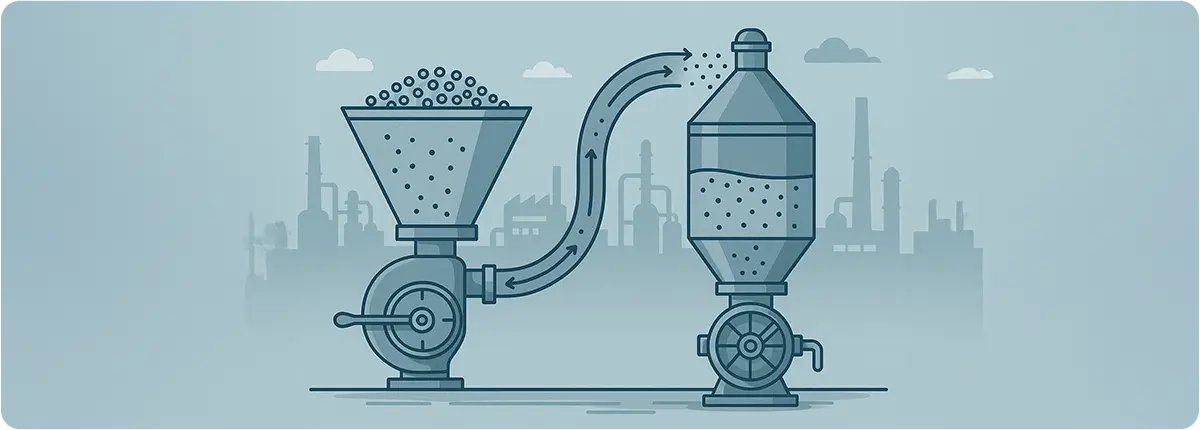Pneumatic conveying systems are widely used in modern industries to transport powders, granules, and bulk solids through pipelines using air as the carrier medium. They offer a closed, hygienic, and efficient method of material handling, making them indispensable in sectors such as food, cement, chemicals, and pharmaceuticals.
This article explores the principles of pneumatic conveying, key engineering calculations, and the types of valves that ensure efficiency and reliability within these systems.

PRINCIPLES OF PNEUMATIC CONVEYING
The core concept of pneumatic conveying is to create a pressure differential that moves solid particles suspended in an air stream through a pipeline. There are two major approaches:
- Positive Pressure Systems: A blower or compressor pushes air into the line, carrying the material forward.
- Vacuum Systems: A vacuum pump creates negative pressure, pulling material into the line.
Conveying can also be classified based on the phase density:
- Dilute Phase Conveying: Material is suspended in high-velocity air (typically 15–30 m/s).
- Dense Phase Conveying: Material moves as plugs or layers at lower velocities (4–12 m/s), reducing degradation and wear.
ENGINEERING CALCULATIONS
Mass Flow Rate of Material:
ṁ = ρs · A · vs
Where:
• ṁ: Mass flow rate (kg/s)
• ρs: Bulk density of material (kg/m³)
• A: Pipe cross-sectional area (m²)
• vs: Conveying velocity of solids (m/s)
Air Volume Flow:
Q = W / (ρa · va)
Where:
• W: Mass of material to be conveyed (kg/s)
• ρa: Air density (kg/m³)
• va: Air velocity (m/s)
Pressure Drop in Pipelines:
ΔP = f · (L / D) · (ρa v² / 2)
Where:
• f: Friction factor
• L: Pipe length (m)
• D: Pipe diameter (m)
• ρa: Air density (kg/m³)
• v: Air velocity (m/s)
Engineering Note: The minimum conveying velocity must remain above the saltation velocity (critical settling velocity), typically around 15–20 m/s, to avoid particle deposition.
VALVES IN PNEUMATIC CONVEYING SYSTEMS
Valves are critical for ensuring air tightness, material dosing, and flow control. The most common valve types include:
- Butterfly Valves: Provide wide openings and minimal pressure drop, ideal for frequent on/off operations.
- Slide Gate Valves: Used to shut off or divert material flow; common in cement and grain systems.
- Rotary Airlock Valves: Serve as both feeders and valves, ensuring controlled material entry while maintaining system air pressure.
- Check Valves: Prevent reverse flow, protecting equipment from pressure surges.
- Quick-Acting Valves: Enable fast line switching in highly automated plants.
ENERGY EFFICIENCY AND AUTOMATION
- Actuated Valves: Pneumatic or electric actuators ensure precise control in automated systems.
- SCADA/PLC Integration: Centralized monitoring and control optimize the entire conveying network.
- Energy Efficiency: Proper valve selection and sealing can reduce air leakage, cutting energy consumption by up to 15%.
APPLICATIONS
- Food Industry: Flour, sugar, coffee, milk powder.
- Chemical and Pharmaceutical: Fine chemicals, active ingredients, powdered excipients.
- Construction Materials: Cement, lime, gypsum.
CONCLUSION
The efficiency of pneumatic conveying systems depends not only on pipeline design and air supply but also on the valves that regulate flow and maintain system integrity. From butterfly and slide gates to rotary airlocks and check valves, the correct valve choice ensures reliable operation, reduced energy costs, and improved system longevity. With automation and modern valve technology, pneumatic conveying continues to be a robust, flexible, and cost-effective solution for bulk material handling.